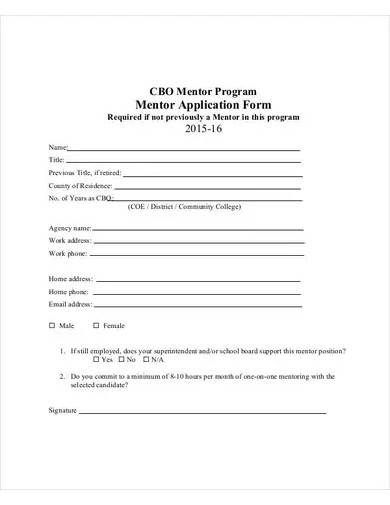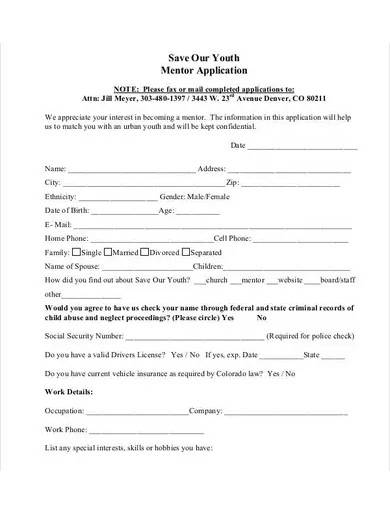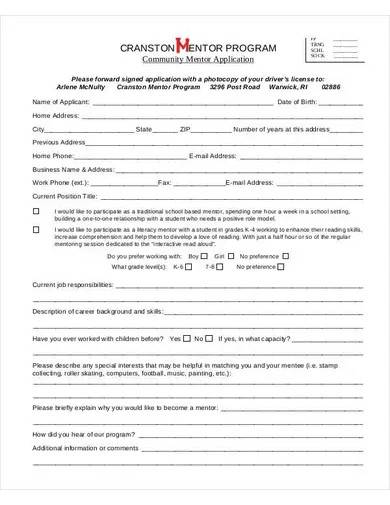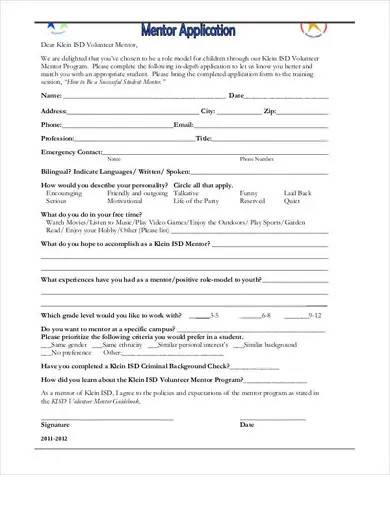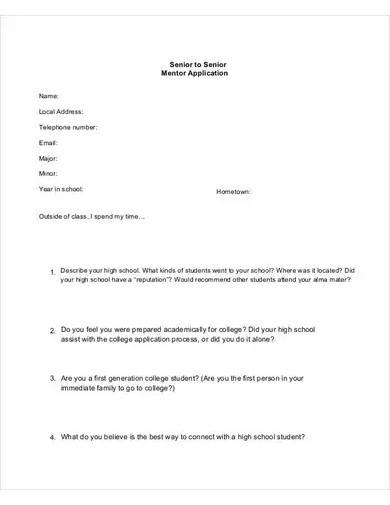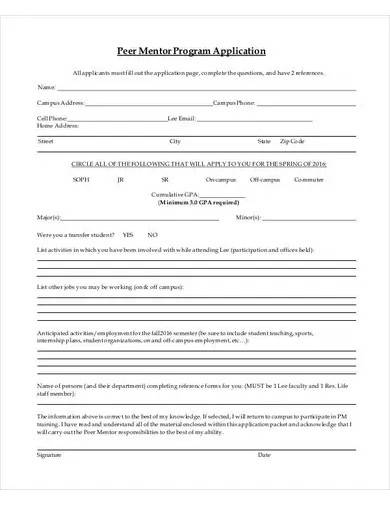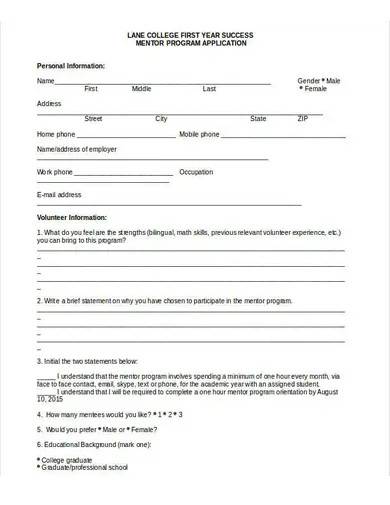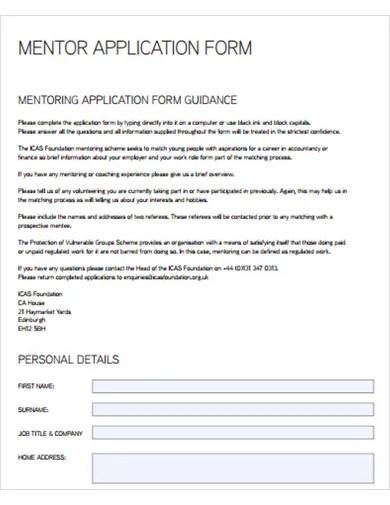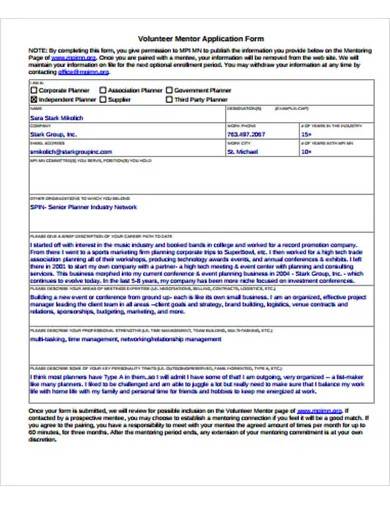Mentorship programs forge a work environment where employees can do their work and learn more than what their roles demand. It provides an opportunity for them to train and to advance in the career ladder. It also creates connections and builds relationships that will encourage them to engage and stay in the organization for a long time. For that to happen, the company needs the best mentors to take on the job. A well-made mentor application form can help select the best candidates for the position. Scroll below and learn more about this.
FREE 10+ Mentor Application Form Samples
1. Mentor Application Form Template
2. Youth Mentor Application Template
3. Sample Community Mentor Application
4. Sample Student Mentor Application
5. Senior Mentor Application Form
6. Mentor Program Application Template
7. Project Change Mentor Application Form
8. Sample Mentor Program Application Template
9. Basic Mentor Application Form Template
10. Mentor Application Form
11. Volunteer Mentor Application Form
What Is a Mentor Application Form?
A mentor application form is a form that a mentor applicant needs to fill out when applying for the position. This document contains information regarding the applicants’ skills, topic knowledge, professional background, and other related experiences that the company can use to evaluate them. It’s a vital tool in recruitment processes, especially in the initial stage, where they need to screen the competition and choose the best candidates.
Why Have a Mentorship Program
Companies offer mentorship programs to train up and coming professionals and show how the industry works through practical activities. This is commonly known as internships integrated by most schools in their programs to help their students learn through active experience and professional guidance. According to Forbes, mentorship contributes to building a better workplace culture because it increases employee satisfaction and retention rates. It also helps both the mentors and mentees develop professionally as this is a step towards promotions.
According to Inc, having mentorship programs that the company looks after its people increases their engagement. The employees can easily ask questions because they’re placed in a setting where they can learn. They can also earn advice from their work processes and output because a mentor supervises their performance actively. This nurtures communications among them, increasing employee engagement, and fostering a healthy environment. It’s also easier to discuss project plans and to come together to complete a schedule because there are cooperative networks present.
Tips on How to Make a Mentor Application Form
Mentorship programs are beneficial to the company only if they hire the best people for the job. A mentorship application form aids human resource recruiters to screen interested applicants and choose the best among the crowd. The following are different tips on how to make one:
1. Gather the Needed Details
Before you start making your mentorship application form, start by making an outline of the details you need to include in your document. You may start the basic personal details such as the name, contact number, and email address. You may want to learn about past job experiences and a brief job description for each. Aside from that, include relevant mentoring activities and skills that they may want to add. These qualifications help you evaluate their background to determine whether or not they’re perfect for the role. This also allows them to showcase their capabilities. This information will serve as the main highlights of your application form.
2. Categorize
When you’re done making a list of the things you want to include on your form, proceed to arrange them on your layout neatly by categorizing them. Separate the basic information, educational background, and work experiences by using different headlines for each. You can also dedicate a spot for the list of skills. If you want to add miscellaneous details, such as their preferred mentorship age groups or their proficient topic areas, you can also separate them from the other information sections of your document. This helps in making your overall layout understandable and easy to fill out for your applicants. This also aids you when reviewing their answers.
3. Keep the Layout Clean and Simple
When you’re done putting all details together, remember to keep the form’s visual layout simple and basic. Avoid using distracting shades. Remember, this is a professional application form, not a creative output. If you want to make it distinctly yours, apply your company’s branding details, such as your company’s color scheme and logo. Use formal fonts and bold headers and titles for emphasis.
4. Include Questions at the End
This is optional, but this helps you get acquainted with your applicants even more if you want to hear about their perspective and goal plans. Include a few open-ended questions such as “What made you choose our company?” “Why do you think you’re perfect for the position?” and “What’s your goal for the next five years?” These might seem like the usual application questionnaire items, but this can contribute a lot to helping you choose the best candidate. This also helps you see the candidates’ personalities beyond their professional records.
FAQs
What are the different types of mentoring?
The different types of mentoring are peer mentoring, career mentoring, and life mentoring.
What are the qualities of an excellent mentor?
Here are the different qualities of an excellent mentor:
- Knowledgeable about a certain topic
- Willing to teach others about what they know
- Always ready to listen and answer pertinent questions
- Efficient in giving comments and feedback
What are the different examples of mentoring techniques?
The different examples of mentoring techniques are:
- Mind mapping
- Asking open-ended questions
- Quality profile
- Career scenarios
- Inquiry
- Active listening
Allowing opportunities where your employees can learn and advance in their profession makes your organization a healthy place to be in. Not only will it encourage people to stay, but it will also make your business an attractive zone for high potential talents. Make this possible by hiring the best mentors with a mentor application form. Go through our application form templates and get yours today for immediate use and easy customization. Download now!
Related Posts
FREE 18+ Sample HR Forms in PDF | MS Word | MS Excel | Google Docs | Pages
FREE 9+ Tutor Report Form Samples in MS Word | PDF
FREE 11+Incident Investigation Form Samples in PDF | DOC
FREE 10+ Retail Form Samples in PDF | MS Word
FREE 10+ Customer Enquiry Form Samples in PDF | MS Word
FREE 10+ Customer Maintenance Form Samples in PDF
FREE 10+ Expense Reimbursement Form Samples in PDF | DOC | Excel
FREE 7+ Distributor Assessment Form Samples in PDF | MS Word
FREE 10+ Legal Client Intake Form Samples in PDF | MS Word
FREE 4+ Child Custody Form Samples in PDF | MS Word
FREE 10+ Mileage Reimbursement Request Form Samples in PDF | MS Word
FREE 10+ Transcript Order Form Samples in PDF | MS Word
FREE 9+ Juror Information Form Samples in PDF | MS Word
FREE 10+ Employee Absence Record Samples in PDF | MS Word
FREE 9+ Sample Consumer Contracts Model Cancellation Forms in PDF

